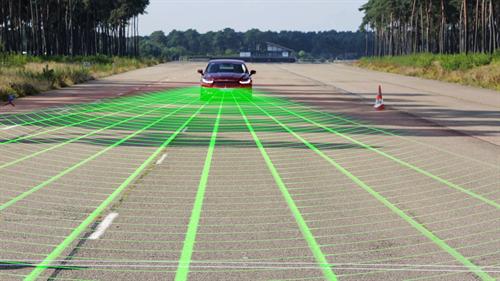 Available new technology from Ford – Pre-Collision Assist with Pedestrian Detection – is designed to reduce the severity of and, in some cases, even eliminate frontal collisions involving pedestrians
Available new technology from Ford – Pre-Collision Assist with Pedestrian Detection – is designed to reduce the severity of and, in some cases, even eliminate frontal collisions involving pedestrians- Pre-Collision Assist with Pedestrian Detection – debuting on the 2015 Ford Mondeo in Europe – provides a collision warning to the driver and, if the driver does not respond in time, can automatically apply the vehicle brakes
- Other available Ford driver-assist technologies include lane-keeping system with lane-keeping aid, Blind Spot Information System (BLIS®) with cross-traffic alert, adaptive cruise control and collision warning with brake support, and active park assist
Ford Motor Company is rolling out a new driver-assist system that can reduce the severity of or even eliminate some frontal collisions involving vehicles and pedestrians.
Pre-Collision Assist with Pedestrian Detection uses radar and camera technology to scan the roadway ahead and, if a collision risk with a vehicle or pedestrian is detected, provides a warning to the driver. If the driver does not respond in time, the system can automatically apply up to full braking force to help reduce the severity of or even eliminate some frontal collisions. Pre-Collision Assist may help drivers avoid rear end collisions with other vehicles at all speeds, while Pedestrian Detection can help the driver avoid pedestrians at lower speeds – both may reduce the severity of forward collisions or even prevent certain forward collisions.
“This technology adds to the already impressive list of driver-assist technologies Ford customers benefit from today,” said Raj Nair, Ford group vice president, Global Product Development.
Pre-Collision Assist with Pedestrian Detection will debut as available technology on the 2015 Ford Mondeo on sale in Europe this year. It will then roll out to other Ford and Lincoln products around the world.
While the new system may be especially helpful in unexpected situations, it does not replace the driver and has limitations including nighttime, low and harsh lighting conditions, vehicles moving in a different direction and certain weather conditions.
Detecting pedestrians
In daylight and clear weather conditions, the new technology may detect people in or near the road ahead, or pedestrians crossing the vehicle’s path. If a pedestrian is detected in front of the car and a collision is imminent, the driver first receives an audible and visual warning. Should the driver not respond, the system improves brake responsiveness by reducing the gap between brake pads and discs. If there is still no response from the driver, the brakes are applied automatically and vehicle speed is reduced.
The system processes information collected from a windshield-mounted camera and radar located near the bumper; it then checks the information against a database of pedestrian shapes to help distinguish people from typical roadside scenery and objects.
Ford engineers tested the system on closed test tracks using rigs fitted with manikins to replicate pedestrians. They then spent months refining the technology on roads around the world to test system reliability.
“This real-world testing was an important part of the development, because pedestrians in an urban setting can present a wide range of potential situations,” said Scott Lindstrom, Ford manager, Driver Assist Technologies. “We covered more than 300,000 miles on three continents that included a wide range of settings and situations.”
Other driver-assist technologies available from Ford include lane-keeping system with lane-keeping aid, Blind Spot Information System (BLIS®) with cross-traffic alert, adaptive cruise control and collision warning with brake support, and active park assist. For more information on these technologies, go to www.ford.com

You must be logged in to post a comment.